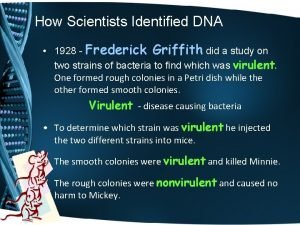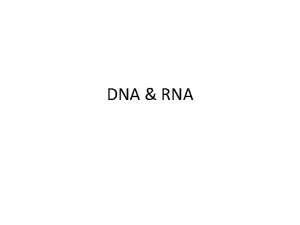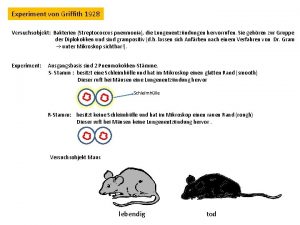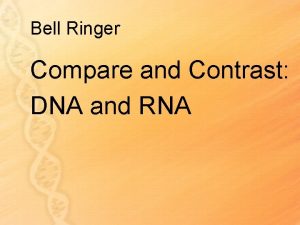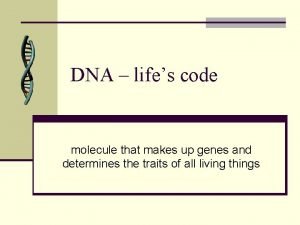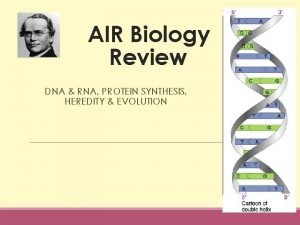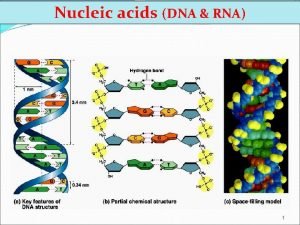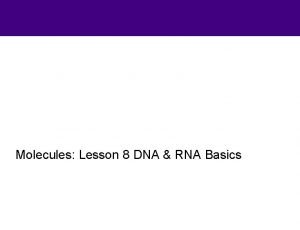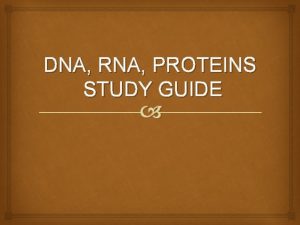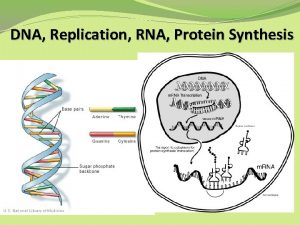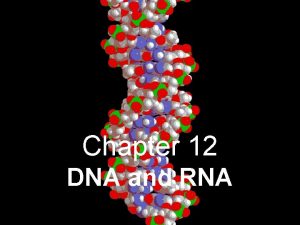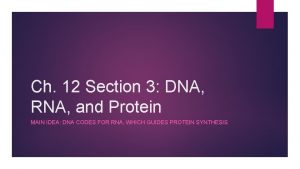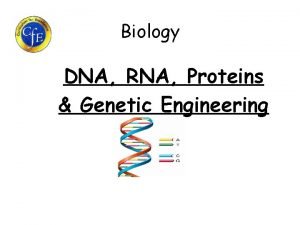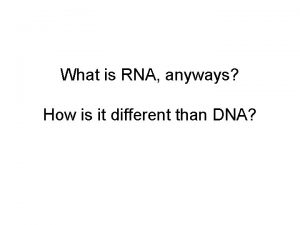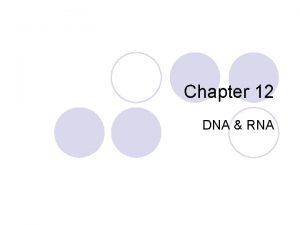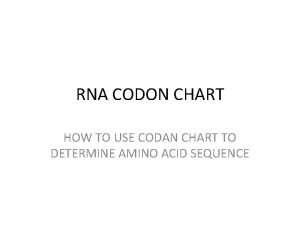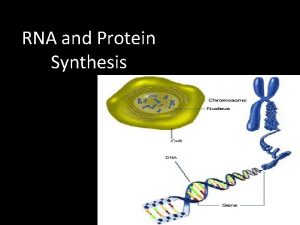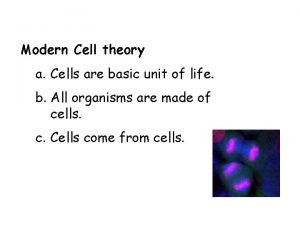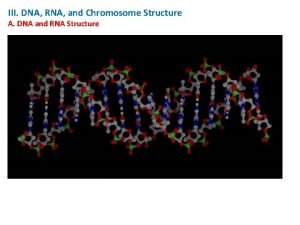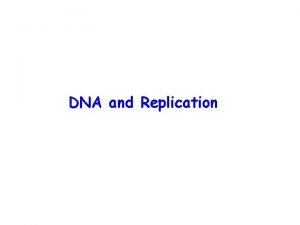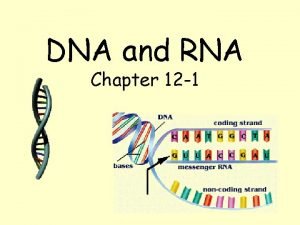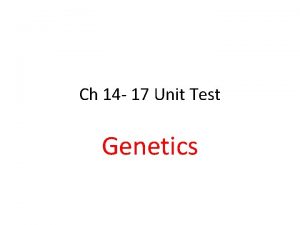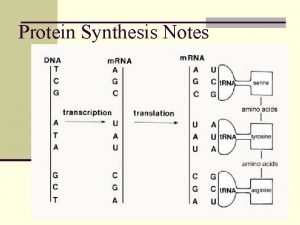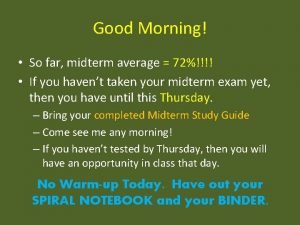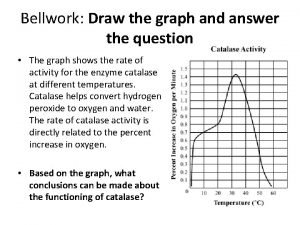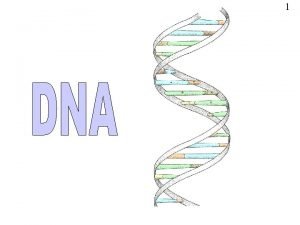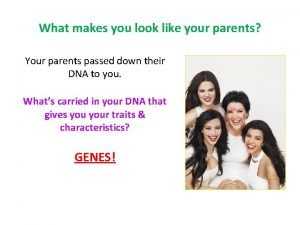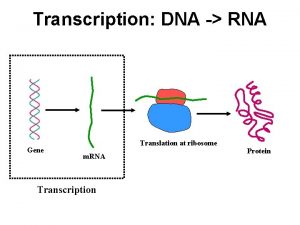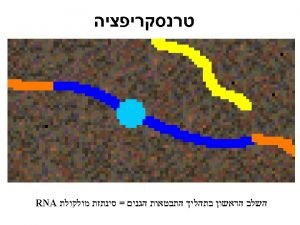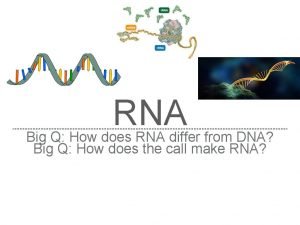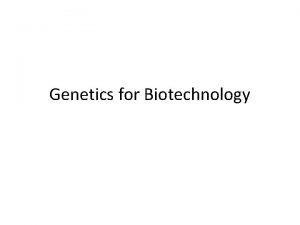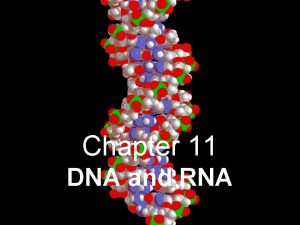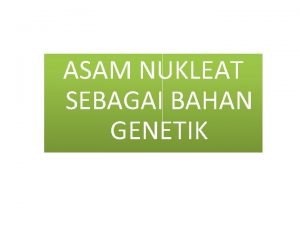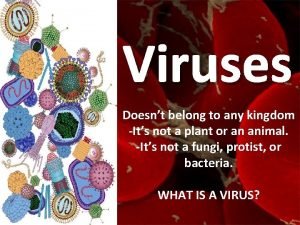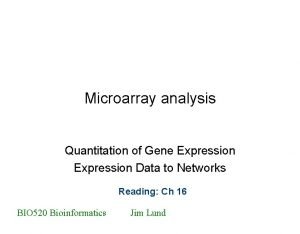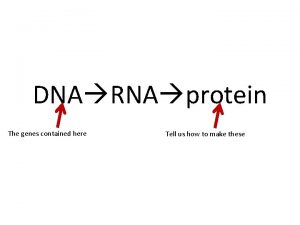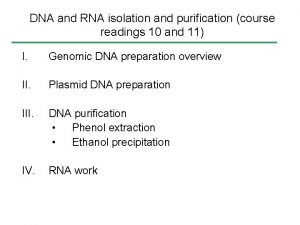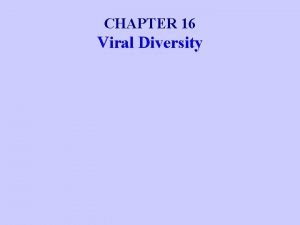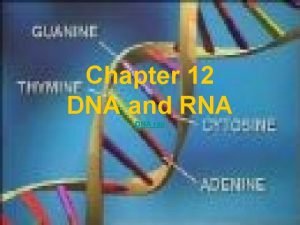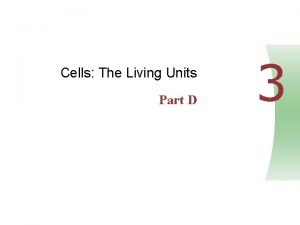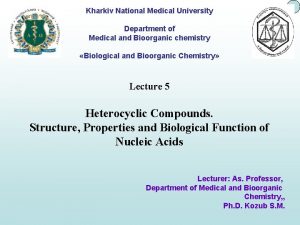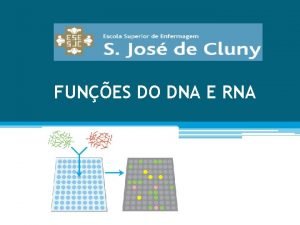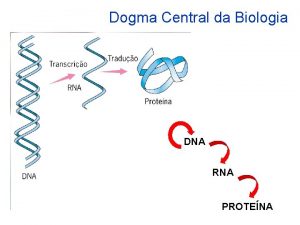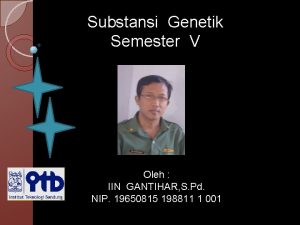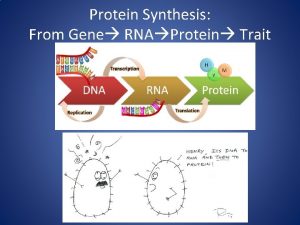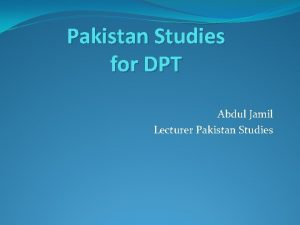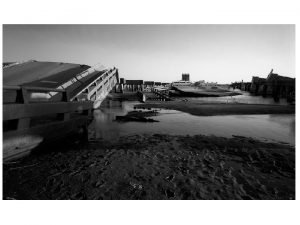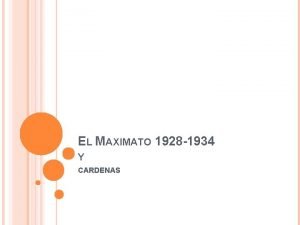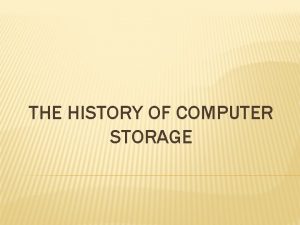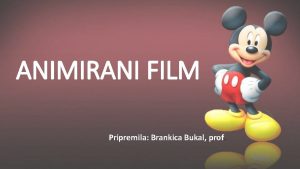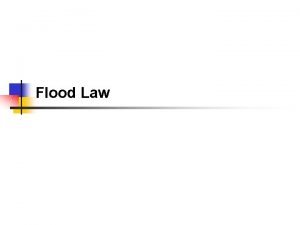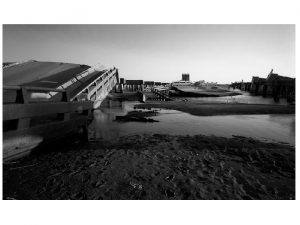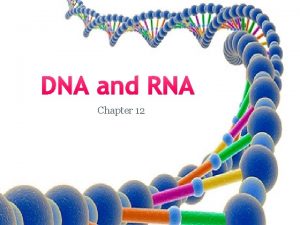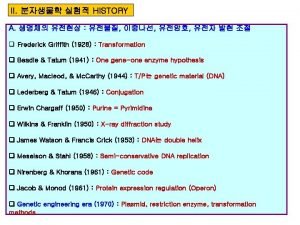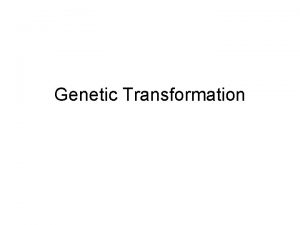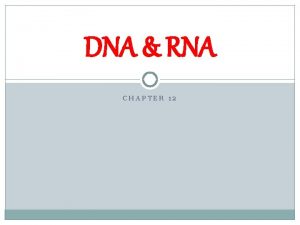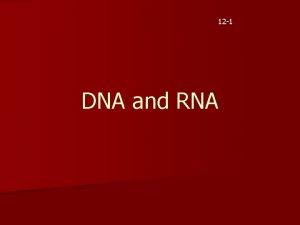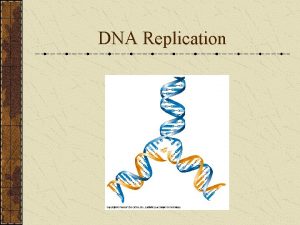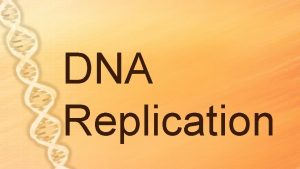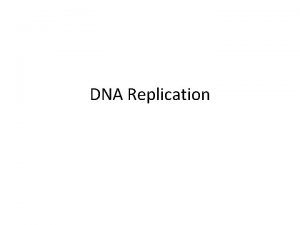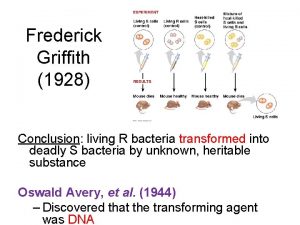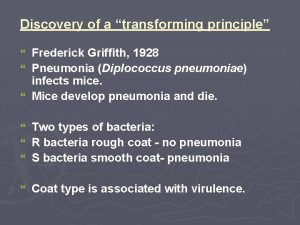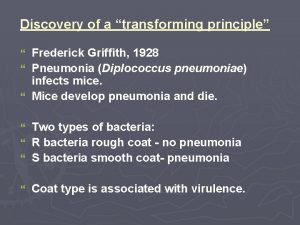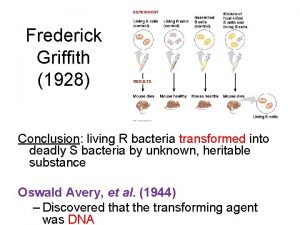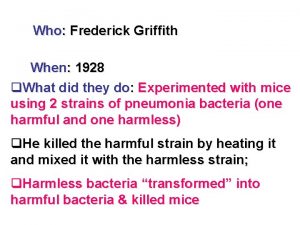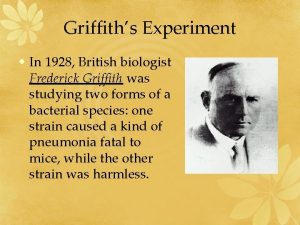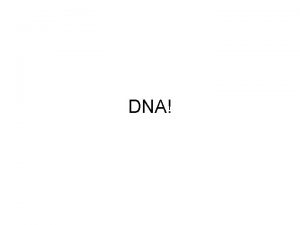DNA RNA Griffith and Transformation 1928 Frederick Griffith































































- Slides: 63

DNA & RNA

Griffith and Transformation • 1928 - Frederick Griffith was trying to figure out how bacteria made people sick • Pneumonia • Cause of pneumonia was not a chemical poison released by disease causing bacteria • The heat killed bacteria had passed their disease-causing ability to the harmless strain

Griffith Experiment

Transformation • Transformation- process in which one strain of bacteria is changed by a gene or genes from another strain of bacteria • Which molecule was responsible?

Avery and DNA • 1944 - Avery, Macleod, and Mc. Carty wanted to determine what molecule in the heat killed bacteria was most important for transformation. • *** Avery and other scientists discovered that the nucleic acid DNA stores and transmits the genetic information from one generation of an organism to the next. • Genes are made of DNA ***Deoxyribonucleic acid

The Hershey-Chase Experiment • • • 1952 - Alfred Hershey and Martha Chase Collaborated in studying viruses Bacteriophage “Bacteria eater” Composed of DNA or RNA core and a protein coat. Bacteriophage enters a bacterium, the virus attaches to the surface of the cell and injects its genetic info into it

The Hershey-Chase Experiment • The viral genes act to produce many new bacteriophages and they gradually destroy the bacterium. • When the cell splits open, hundreds of new viruses burst out. • Need to determine which part of the virus ( the protein coat or the DNA core) entered the infected cell • They would determine whether genes were made of protein or DNA

The Hershey-Chase Experiment • Concluded- The genetic material of the bacteriophage was DNA, not protein. • NEED radioactive stuff • http: //www. youtube. com/watch? v=9 hz. Ujx_o. D 8 E • http: //www. youtube. com/watch? v=e. Tvmpn 467 q 0 • http: //www. youtube. com/watch? v=z. GSSDJh. Hgp 0

The components and structure of DNA • Three critical things genes were known to do – Carry info from 1 generation to the next – Put that info to work by determining the heritable characteristics of organisms – Had to be easily copied, because all of a cell’s genetic info is replicated every time a cell divides

The components and structure of DNA • DNA is a long molecule made up of units called nucleotides • Two strands form a double helix

The components and structure of DNA • Nucleotides • 3 components: – Phosphate grp – Pentose ( 5 carbon sugar) - deoxyribose – Nitrogenous base (contain nitrogen)

Four kinds of nitrogenous bases PURINES Guanine Adenine Two ring structure PYRIMIDINES Cytosine Thymine One ring structure

The components and structure of DNA • Backbone of a DNA formed by – Sugar and phosphate • Nitrogenous bases stick out sideways from chain

The components and structure of DNA

Replication Prokaryote Eukaryote • Lack nuclei and other organelles • Single circular DNA • DNA molecules found in cytoplasm • 1000 x amt of DNA than Prokaryote • Found in nucleus form of a # of chromosomes • Humans- 46 chromosomes • Drosophilia fly-8 • Giant Sequoia tree- 22

DNA Replication • Needs to be folded “nicely” inside of cell to be able to be unraveled easily. • DNA and protein packed together to form- chromatin. • Chromatin – DNA that is tightly coiled around proteins called histones. • DNA and histones form a beadlike structure- nucleosome. • Nucleosome- - tightly coiled and super coiled to form chromosomes • http: //www. youtube. com/watch? v=gb. SIBh. Fw. Q 4 s&NR=1


DNA Replication

DNA Replication • Two parental strands serve as template strands • New nucleotides must obey the AT/GC rule • End result 2 new double helixes with same base sequence as original

DNA Replication Easy as 1, 2, 3 !!!

Step 1 • DNA strand unwinds and the hydrogen bond is broken between the two sides of the ladder.

Step 2 • An enzyme DNA polymerase will use the original strand of DNA to match new complimentary nucleotides to the original strands. .

Step 2 Illustrated

Step 3 • New nucleotides would be put in place on both old strands to produce two new DNA molecules.

DNA Replication • During DNA replication, the DNA molecule separates into two strands, then produces two new complementary strands following the rules of base pairing. Each strand of the double helix of DNA serves as a template, or model, for the new strand. • http: //www. youtube. com/watch? v=hf. Z 8 o 9 D 1 tus&feature=re lated

DNA Replication • Origin of replication– Prokaryote- single origin – Eukaryote- multiple origins • Starts at replication forks • Replication proceeds outwards in opposite directions • Enzymes – “unzip” (helicase) a molecule of DNA – Breaks the hydrogen bonds

DNA Replication • As new strand forms follows base pairing • DNA Polymerase- joins individual nucleotides to produce a DNA molecule. • DNA Polymerase also “proofreads” to make sure each new strand is a perfect copy. • http: //www. youtube. com/watch? v=hf. Z 8 o 9 D 1 tus&feature=related



DNA Replication • Replication is very accurate – Hydrogen bonding between base pairs more stable – Polymerase unlikely to form bonds if pairs are mismatched – Polymerase removes mismatched pairs – Proofreading results in DNA polymerase backing up and digesting linkages – Other DNA repair enzymes are involved

January 28, 2019 • Please vault your phone • Bell Ringer – Where in the cell does replication take place? – What is the end result of mitosis? – Where are proteins made in the cell?

Transcription and Translation: protein synthesis How is the genetic information stored in DNA transformed into parts and functions of living organisms?

List proteins you can think of • • • Antibodies Contractile proteins- movement Enzymes Hormones- messengers for body functions Structural- Keratin, collagen, Transport proteins

DNA in the nucleus Ribosomes outside of the nucleus

There are three differences in DNA and RNA structure: 1. RNA is single stranded 2. The sugar in RNA is ribose (DNA contains deoxyribose) 3. RNA contains uracil instead of thymine

TRANSCRIPTION DNA language RNA language

TRANSCRIPTION DNA language RNA language • Definition- RNA polymerase binds to DNA and separates the DNA strands. RNA polymerase then uses one strand of DNA as a template from which nucleotides are assembled into a strand of m. RNA • http: //www. youtube. com/watch? v=zt. Pkv 7 wc 3 y. U&feature=related

TRANSCRIPTION DNA language RNA language • • 3 steps Initiation Elongation Termination

TRANSCRIPTION DNA language RNA language • INITIATION – RNA polymerase bind only to regions of DNA- promoters • Have specific base sequences • signals to start transcribing

Elongation the process through which nucleotides are added to the growing RNA chain.

• TERMINATION – RNA polymerase reaches the termination sequence on the strand – This causes the newly made m. RNA dissociate from the DNA – Hairpin loop forms in m. RNA – causing it to come off – http: //www. youtube. com/w atch? v=zt. Pkv 7 wc 3 y. U&featur e=related

TRANSCRIPTION DNA language RNA language • New m. RNA need to be “edited” before Translation. • DNA has sequences that aren’t involved in protein synthesis – introns • DNA sequences that code for proteins – exons • Still in the nucleus- introns are cut of m. RNA sequence • Exons are spliced together • Cap and tail are added to form final m. RNA molecule

Translation RNA Protein • • • Antibodies Contractile proteins- movement Enzymes Hormones- messengers for body functions Structural- Keratin, collagen, Transport proteins

Translation RNA Protein

Translation RNA Protein • Proteins are made by joining long chain of amino acids • Codon- three consecutive nucleotides that specify a single amino acid

Translation RNA Protein • The cell uses information from messenger RNA to produce proteins • 3 steps – Initiation – Elongation – Termination • But first…… – m. RNA is transcribed from DNA in the nucleus and released into the cytoplasm

Translation RNA Protein Initiation • r. RNA provides the site for translation • AUG is the start codon • m. RNA attaches to a ribosome • t. RNA brings the proper amino acid to the ribosome

Translation RNA Protein • TERMINATION • Stop codon is encountered the ribosome and m. RNA detach and the amino acid is released • http: //www. youtube. com/watch? v=B 6 O 6 u. Rb 1 D 38&feature=related

Translation RNA Protein

A ribosome carries out translation. The genetic code carried by m. RNA is translated (decoded) into a sequence of amino acids. Amino acids are carried to a cluster of ribosomal RNA (r. RNA) on the ribosome by transfer RNA (t. RNA).


A sequence of three nucleotides form a unit called a codon.


February 3 Bell Ringer: 1. Write a short paragraph explaining what you learned last class. Talk to your table partner to refresh your memory! 2. Please turn in your homework

Person-to-person secret message DNA to the rest of the cell and the organism’s body Where does the message originate? The brain/A thought A gene (DNA is stored in the nucleus) How was the message encoded? Number code m. RNA What do we get from the code? words amino acid What is the result? When words are added together, we get a sentence. Hello there! These are sentences. The end. When amino acids are added together, we get a protein.

Mutations are changes in the genetic material

Mutations are changes in the genetic material • Point mutation – changes in one or a few nucleotides. They occur at a single point in the DNA sequence. – Substitutions, insertions and deletions

Sickle cell anemia • Missense mutation – base substitution that changes a single amino acid on a polypeptide sequence. • Involves a mutation in the gene that code for the proteins that makeup hemoglobin.


DNA Replication • DNA to Chromosomes • http: //www. allthingsscience. com/video/715/ Human-Chromosomes • http: //www. youtube. com/watch? v=OSt. I 5 pni. H PA&feature=related

RNA editing


 Griffith
Griffith Frederick griffith 1928
Frederick griffith 1928 3 componets of dna
3 componets of dna Griffith experiment
Griffith experiment Chapter 11 dna and genes
Chapter 11 dna and genes Rna transfer
Rna transfer Venn diagram of dna and rna
Venn diagram of dna and rna What is the goal of replication
What is the goal of replication Venn diagram of transcription and translation
Venn diagram of transcription and translation Dna double helix coloring worksheet answer key
Dna double helix coloring worksheet answer key Rna types
Rna types Types of rna and dna
Types of rna and dna Dna and rna
Dna and rna Dna rna and proteins study guide answers
Dna rna and proteins study guide answers Difference between dna and rna extraction
Difference between dna and rna extraction Lenine
Lenine Chapter 12 dna and rna
Chapter 12 dna and rna Chapter 12 section 3 dna rna and protein
Chapter 12 section 3 dna rna and protein Dna protein synthesis study guide answers
Dna protein synthesis study guide answers Dna and rna
Dna and rna Rna or dna
Rna or dna Section 12-1 dna
Section 12-1 dna Rna codon chart
Rna codon chart Dna and rna venn diagram
Dna and rna venn diagram What is the process called
What is the process called Dna dehydration synthesis
Dna dehydration synthesis Minor groove
Minor groove Chapter 12 dna and rna section 12-1
Chapter 12 dna and rna section 12-1 In his transformation experiments what did griffith observe
In his transformation experiments what did griffith observe Unlike dna, rna contains
Unlike dna, rna contains Amoeba sisters mutations worksheet
Amoeba sisters mutations worksheet Dna to rna rules
Dna to rna rules Dna vs rna nitrogen bases
Dna vs rna nitrogen bases Dna to protein steps
Dna to protein steps Dna to rna transcription
Dna to rna transcription Rna or dna
Rna or dna Big q
Big q Dna rna protein central dogma
Dna rna protein central dogma Virusmax
Virusmax Rna dna
Rna dna Protein dalam sel
Protein dalam sel What kingdom do viruses belong to
What kingdom do viruses belong to Microarray analysis
Microarray analysis Dna rna protein
Dna rna protein Dna rna protein diagram
Dna rna protein diagram Corona virus dna or rna
Corona virus dna or rna Dna rna
Dna rna Dna to rna transcription
Dna to rna transcription Protein synthesis
Protein synthesis Nucleic acids
Nucleic acids Somatic vs germ cells
Somatic vs germ cells Dna vs rna
Dna vs rna Proteinas histonas
Proteinas histonas Attcga
Attcga Substansi genetik dna dan rna mempunyai kesamaan yaitu
Substansi genetik dna dan rna mempunyai kesamaan yaitu Protein
Protein Coding dna and non coding dna
Coding dna and non coding dna Nehru report 1928
Nehru report 1928 Flood control act of 1928
Flood control act of 1928 Qué es el maximato
Qué es el maximato 1928 magnetic tape
1928 magnetic tape Parobrod willy 1928
Parobrod willy 1928 Flood control act of 1928
Flood control act of 1928 Flood control act
Flood control act

